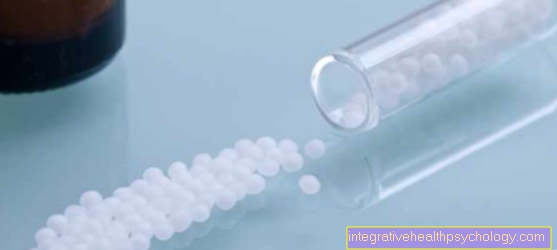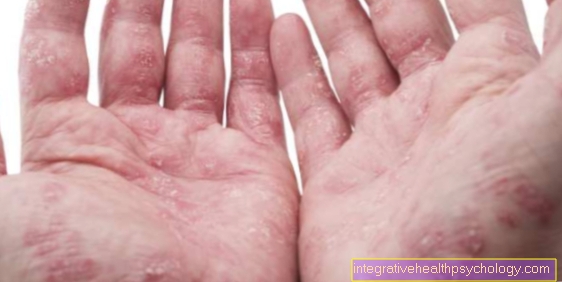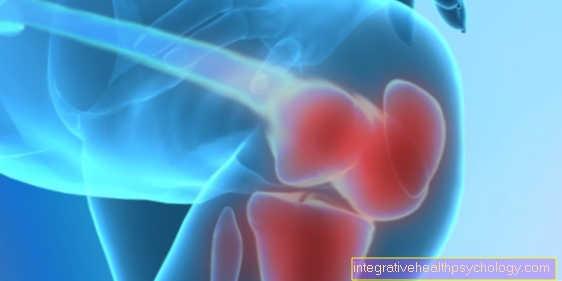eyelash
Anatomy of the eyelash
The eyelashes, Latin ciliae, are appendages of the skin occurring in mammals as well as in humans.
They are located in the form of curved hairs on the edge of the upper and lower eyelids and completely surround them as a so-called lash line.
They form two to four rows and serve to protect sensitive eyes.
The eyelashes are part of the bristle hair. In their shape they are short, rigid and curved.
The number of eyelashes per eye varies between 50 and 250 eyelashes.
In order not to restrict the view, they are curved upwards on the upper eyelid and downwards on the lower eyelid.
On the upper eyelid there are more (approx. 200) and longer (approx. 10 mm) eyelashes, on the lower eyelid they are shorter (approx. 7 mm) and fewer (approx. 75).
The eyelashes arise from the roots of the hair.
This is surrounded by sebum glands, the Zeiss and Meibomian glands.
In contrast to most other hairs in the body, eyelashes do not have a muscle that can straighten them, the so-called erector pili muscle.
The length of the eyelashes on the upper eyelid differs from that on the lower eyelid: Above are the longer eyelashes with a length of about 8 to 12mm. At the Lower eyelid they are only 6 to 8mm long.
The lifespan of the eyelashes is relatively short: after 100 to 150 days they are shed from the skin of the eye and replaced with new eyelashes.
The time it takes to grow new eyelashes is approximately 10 weeks. Cutting off or tearing off the eyelashes is compensated by the body through regrowth.
Via their root-like anchoring to the Eyelids, on which sebum and Sweat glands the eyelashes get theirs nutrient, for example fat. This keeps the lashes supple. Usually the eyelashes are the same color as the hair on the head and body.
If the eyelashes are touched unexpectedly, the eye is reflexively closed. The eyelashes interlock and form a kind of catching cage. This becomes the eye protected from possible foreign bodies. This is happening within about 250 milliseconds. The eyelashes are lubricated by various glands on the base of the eyelashes.

Function of the eyelash
The main task of the eyelashes is to protect our eyes. Due to their dense arrangement on the upper and lower eyelids, they prevent sweat, dirt particles and foreign bodies from penetrating our sensitive eyes. In addition, the eyelashes guarantee to a certain degree protection against intense light and solar radiation, which in high doses can damage the eye.
In our day and age, eyelashes, especially women, are increasingly being assigned an aesthetic importance. They are usually treated cosmetically with mascara (mascara or eyelash spiral) to make them appear longer and fuller. This is probably due to the fact that lashes that appear voluminous and strong represented a selection advantage in evolutionary history: Long, thick lashes were considered a beauty feature in prehistoric times, as they were viewed as a property of a healthy and defensive body.
Ingrown eyelashes
In case of ingrown eyelashes, medically also as Distichiasis designated, In addition, eyelash-like hairs grow from the glandular openings in the edge of the eyelid towards the eye. They look like a second row of eyelashes. It is a congenital disease that occurs in humans or other mammals, such as dogs or horses, and can affect one or both eyes and the upper or lower eyelid. The growth of the eyelashes in the direction of the eyeball can lead to an unfavorable growth direction uncomfortable permanent irritation up to Inflammation of the cornea or conjunctiva of the eye come. Additionally, this can become a increased tearing and to one Ulceration of the cornea to lead. The diagnosis is made by the ophthalmologist on the basis of the clinical symptoms and a supplementary examination of the eye.
The diagnosis is provided by the examining ophthalmologist through the clinical symptoms and an examination of the eye. The therapy depends on the severity of the disease. Ingrown eyelashes are usually professionally and sterile removed by the ophthalmologist using tweezers. Danger! Never remove the ingrown eyelash yourself! Different therapeutic measures can be used. The so-called is preferred Cryotherapy applied. Here is a Coolant directly on the pathologically changed area applied or introduced. The goal is that Freezing of the diseased tissuewhich by gets destroyed. Further procedures are the Electroepilation, with permanent Removal of the excess hair or the surgical removal of the surplus eyelashes by means of surgery.
Is the cause in one abnormal inward rotation of the eyelid towards the eyeball, there is the possibility in one corrective outward rotation "without surgery" Traction plaster or "operational" by that Insertion of rein suturesturning the lid outwards. At a Malformation of the eye can mean a surgical correction Operation of the eyelid Get a remedy. The inflammation is treated with certain eye drops and ointments.
Eyelash under upper eyelid - what to do?
If an eyelash gets under the upper eyelid, this can be very uncomfortable.
The eye is watering and burning.
If a second person is present, they can easily remove the eyelash.
The person concerned has to look down while the helper grabs the upper eyelid at the origin of the eyelashes and pulls it over the lower eyelid.
Normally, the eyelash should now be removed from the lower eyelid.
To remove the eyelash, one can try to rinse the eye.
You can use simple tap water that is poured into a bottle.
Under no circumstances should sparkling water be used, as this is additionally irritating to the eyes.
The water is run over the eye, from the side of the nose to the outer corner of the eye.
The affected eye should be open, e.g. it can be kept open with the fingers.
Another person's help is often useful.
If the eyelash cannot be removed by rinsing, you can try to retrieve it with a swab.
A helper is also required for this.
The affected person looks down, the helper carefully pulls the upper eyelid outwards and upwards by the eyelashes.
If the eyelash becomes visible, it can be removed from the eye with a clean swab.
Extreme caution should be exercised when doing this.
If the eyelash still cannot be removed, a doctor's visit may be necessary.
Excessive rubbing of the eye can damage the skin and is therefore not recommended.
The doctor removes the eyelash using the flip-over technique, known as ectropioning.
To do this, he folds the upper eyelid upwards with the help of a cotton swab.
This can be uncomfortable, but it is not painful and leads to rapid improvement after removing the eyelash.
In particularly stubborn cases, double ectropionation may be necessary.
The doctor uses a special instrument to roll the upper eyelid upwards so that its underside is exposed.
The eyelash can now be easily removed.
Eyelash scrubbing
The so-called Eyelash scrubbing, medicinally as Trichiasis referred to, it comes to one abnormal rubbing of the eyelashes on the surface of the cornea or conjunctiva. This disease is not congenital, like distichiasis, but acquired. A Possible Cause lies in one misdirected growth of hairs towards the eyeball.
Another is the inward rotation of the eyelid, the so-called Entropion, caused. Most of the time they play Malformations of the eye a major role.
The lash scrubbing can separate Eyelashes, too whole rows of eyelashes affect. Those affected often complain about Foreign body sensation in the eye. In addition, it can become a Inflammation of the eye with redness, itching and stinging come. With permanent irritation of the Cornea of the eye through the eyelashes, it can lead to the formation of Ulcers and Scars of the cornea come. In the worst case, you can scrub your eyelashes with you Loss of visual acuity hand in hand.
Eyelashes fall out
Like other body hair, eyelashes fall out after their lifespan of around 100-150 days.
However, if this lifespan is drastically shortened or if not enough eyelashes grow back, the eyelashes may fail.
This can have different causes.
An unnaturally strong eyelash loss is called madarosis (pathological eyelash loss).
Madarosis can have various causes, e.g. chronic inflammation of the eyelid margin (chronic blepharitis).
The lid is often swollen and reddened and the eyelashes can stick together.
Certain medications also cause eyelashes to fall out.
These include, for example, various chemotherapies.
Irradiation for cancer treatment can damage eyelashes.
Drugs used to treat glaucoma can also cause madarosis.
This happens particularly frequently with so-called prostagalandin antagonists.
The reason for poorly growing eyelashes is often an insufficient supply of various vitamins or nutrients as well as stress.
If the body is undersupplied, it usually tries to bundle its remaining resources for vital organs.
There are then no longer enough funds available for the production of eyelashes.
A balanced diet can help here.
A very common reason for eyelashes to fall out can also be excessive make-up.
The fine eyelashes are very sensitive and are easily attacked by various care products.
The pull on the eyelashes, which is often used when applying make-up, can also weaken them.
But also allergic reactions, e.g. to make-up, can cause eyelash loss and have symptoms similar to blepharitis.
In this case, contact lenses and make-up should be left out for a few days; if symptoms are severe or persistent, it is advisable to consult a doctor.
In addition, hormonal disorders can be responsible for eyelash loss, e.g. if hormones of the adrenal cortex, thyroid or the genital organs are affected.
The exact cause should be clarified and treated by a doctor.
In addition, circular hair loss can also occur on the eyelashes.
Loss of eyelashes should be examined by a doctor due to the multitude of causes.
This is especially true if it happens suddenly and quickly.
In very severe, stressful cases, a decision about cortisone therapy can be made here with the doctor.
Further information on this topic can be found at: Eyelashes fall out - what to do?
Madarosis
With the so-called Madarosis, it comes to one abnormal loss of eyelashes and the lateral eyebrows. The cause for this is usually one chronic inflammation of the eyelid (Blepharitis), which leads to hair loss. Other triggers can be Vitamin deficiency, various skin diseases, Drug side effects in cancer therapy, stress, trauma or Burns be. Most of the time, the eyelashes grow back after the underlying cause has been corrected. Otherwise, the use of artificial eyelashes is recommended.
Eyelash serum
Various sellers offer so-called eyelash serums, especially over the Internet.
These should have a positive effect on eyelash growth and thus ensure the desired longer and thicker eyelashes.
To do this, they are usually applied to the eyelashes or dripped into the eye.
The ingredients are sometimes very different depending on the manufacturer.
One of the most powerful substances are the prostaglandins.
These are hormones, i.e. chemical messenger substances in the body.
Prostaglandins have a variety of tasks. For example, they are released when there is inflammation and are used to generate fever.
In addition, prostaglandins widen the blood vessels and thus ensure a better supply of nutrients and oxygen.
When treating patients with glaucoma with one of these substances, it was discovered that they also make the eyelashes grow.
The reason for this is presumably a longer lifespan of the eyelashes.
As a result, the product was also approved in the USA for the treatment of falling eyelashes.
A well-known active ingredient is bimatoprost.
However, prostaglandins can have numerous side effects, such as irritation or inflammation of the eyes, headaches and intolerance.
Substances that imitate the effects of prostaglandins are usually better tolerated.
However, they often need more time to take effect.
It should be mentioned that there are no studies to date that show whether the use of eyelash serums has effects on the whole body.
Therefore, damage cannot be completely ruled out.
In addition, the effect is different for each person and cannot be guaranteed
However, caution is advised with many remedies.
The exact active ingredient is often not mentioned or only touted as a "revolutionary discovery".
On closer inspection, the effect is only limited to tinting the existing eyelashes, which makes them appear fuller.
It is also questionable to what extent an agent applied externally to the eyelashes can even reach the hair roots.
Therefore, caution should be exercised when purchasing products such as eyelash serums.
This is especially true when advertising with apparent experience reports and false studies.





























